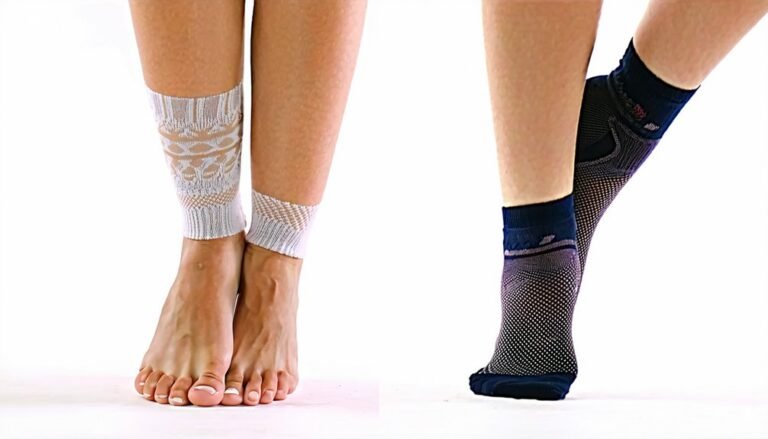Chains Vs Snow Socks
When choosing between tire chains and snow socks, consider your driving needs and conditions. Tire chains, though more complex to install, offer superior traction for frequent travel in harsh winter conditions. They're durable but may damage roads. Snow socks, on the other hand, are quick to install, quieter, and gentler on roads, making them suitable for occasional use but less effective on bare pavement. Knowing which is best for your situation will enhance safety and performance. Discover more nuances.
Understanding Tire Chains

Tire chains are essential tools for enhancing traction on icy or snow-covered roads, providing an effective solution for traversing challenging winter conditions. When you understand tire chain types, you're better equipped to choose the right one for your vehicle. There are several types, including cable, diamond, and ladder chains. Each type offers unique benefits and suitability for different vehicles and terrains.
When installing tire chains, follow these installation tips for safety and efficiency: verify chains are the correct size for your tires, practice installation in dry conditions for familiarity, and check tension regularly during use to prevent slippage. Proper installation not only maximizes performance but also minimizes the risk of damage to your tires and vehicle, guaranteeing a secure journey through winter's toughest challenges.
Exploring Snow Socks
While tire chains are a well-known option for improving traction in winter conditions, snow socks offer an alternative that combines ease of use with effective performance. Snow socks are fabric-based covers that slip over your tires, enhancing grip in snowy conditions. Their benefits include quick installation and reduced noise compared to metal chains. However, snow sock limitations must be considered, such as less durability on bare pavement and decreased effectiveness in deep snow.
Here's a quick comparison:
| Feature | Snow Socks | Tire Chains |
|---|---|---|
| Installation | Quick and simple | Time-consuming |
| Noise Level | Quiet | Noisy |
| Surface Impact | Minimal | Can damage roads |
| Durability | Moderate | High |
| Deep Snow | Less effective | Highly effective |
Understanding these factors will help you make an informed choice for winter safety.
Performance on Icy Roads
When evaluating performance on icy roads, it's crucial to take into account how both snow socks and tire chains interact with the road surface. Tire chains offer superior traction control by digging into ice, providing a secure grip. They're known for enhanced road safety in extreme conditions, making them a reliable choice when the ice is particularly treacherous. However, their aggressive design can sometimes damage the road surface or the tires themselves if not used correctly.
In contrast, snow socks are gentler on both the road and your tires. They offer adequate traction control by creating friction between the tire and the ice. While they might not match the grip of chains, they excel in moderate icy conditions, balancing safety and preservation of road quality.
Ease of Installation and Removal
How do tire chains and snow socks compare regarding ease of installation and removal? Tire chains require a more complex installation process, often involving jacks and careful alignment, which might be intimidating in a snowstorm. Conversely, snow socks boast a straightforward installation, slipping over tires with minimal effort. Removal techniques also differ: chains need meticulous detachment to avoid damaging the vehicle. In contrast, snow socks can be pulled off quickly.
Here's a concise comparison:
| Aspect | Tire Chains | Snow Socks |
|---|---|---|
| Installation Process | Complex | Simple |
| Tools Required | Possibly needed | None |
| Time Required | Longer | Shorter |
| Removal Technique | Detailed | Quick |
Ultimately, snow socks offer a user-friendly alternative, enhancing safety for drivers prioritizing ease and efficiency.
Durability and Longevity

Ease of installation and removal is just one factor in choosing between tire chains and snow socks. When considering durability and longevity, you must weigh material comparison and wear resistance. Tire chains, typically made from steel alloys, offer exceptional durability, making them ideal for frequent use in harsh conditions. In contrast, snow socks, constructed from high-strength fabric, provide less wear resistance but are suitable for occasional use.
- Material Comparison: Steel chains vs. high-strength fabric
- Wear Resistance: Chains excel in longevity for rugged terrains
- Usage Frequency: Chains for regular, socks for occasional
Your decision hinges on evaluating these aspects. If your priority is maximizing safety in severe conditions and you frequently encounter icy roads, chains might be your best bet. However, for lighter use, snow socks offer a viable option.
Cost and Accessibility
While evaluating the cost and accessibility of tire chains versus snow socks, it's crucial to take into account both the initial purchase price and the broader availability. Regarding cost comparison, snow socks generally present a lower upfront expense compared to chains. However, the long-term investment might lean towards chains due to their durability. When considering accessibility factors, snow socks are easier to find in regions with moderate snow and can be quickly installed without tools, appealing to those prioritizing convenience and efficiency. Chains, on the other hand, are more readily available in areas accustomed to heavy snowfall and may require more effort to purchase and use. Your choice should align with your environmental conditions and safety priorities.
Frequently Asked Questions
Are Chains or Snow Socks More Environmentally Friendly?
You're wondering about the environmental impact of traction aids. Consider snow socks: they're often made from sustainable materials and may have less impact on infrastructure damage. Chains, however, offer durability but could potentially harm roads, affecting long-term sustainability.
How Do Chains and Snow Socks Impact Fuel Efficiency?
You'll notice a colossal difference in fuel consumption when using traction aids. Chains can slightly increase it due to weight and drag, while snow socks, being lighter, might offer better traction performance without greatly impacting fuel efficiency.
Can Chains or Snow Socks Be Used on Muddy Terrains?
You're considering muddy terrains, so focus on terrain suitability. Chains provide better muddy traction due to their durability and grip. Snow socks aren't designed for mud, lacking the necessary strength and can compromise your safety in such conditions.
Do Chains or Snow Socks Affect Vehicle Warranty?
You might void your warranty coverage if you don't follow manufacturer guidelines when using tire accessories. It's essential to guarantee any product complies with your vehicle's specifications to maintain safety and protect your warranty rights.
Are There Legal Restrictions on Using Chains or Snow Socks?
You'll need to check state regulations for legal requirements on traction devices. Some states mandate chains in severe conditions, while others allow snow socks. Verify your choice complies with local laws to prioritize safety and avoid penalties.







